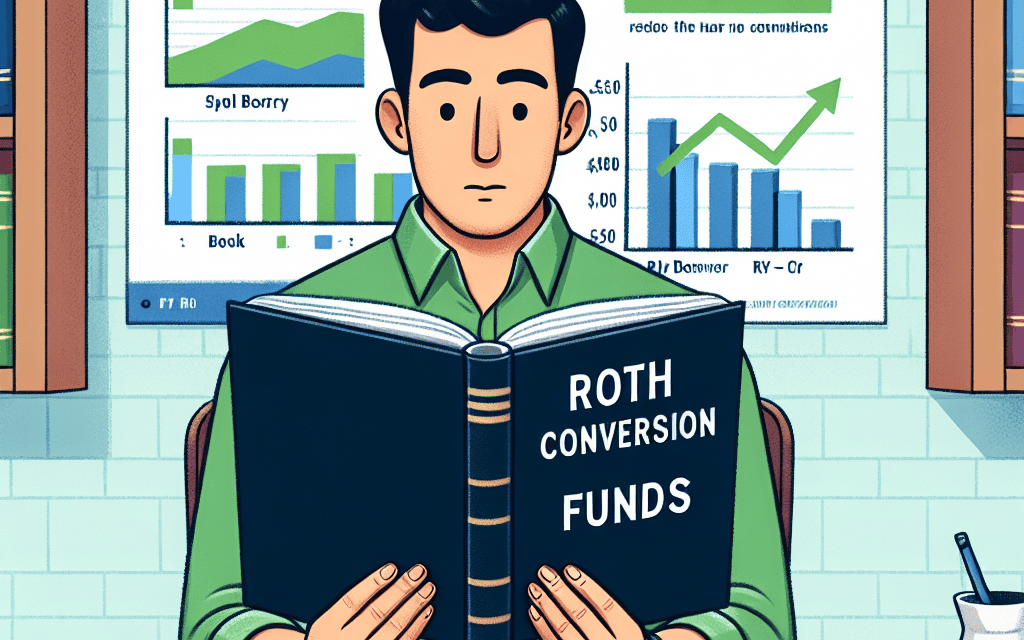“Maximize Your Roth: Smart Strategies for Funding Your $250k Conversion Tax Bill”
Introduction
A Roth conversion involves transferring funds from a traditional IRA or 401(k) into a Roth IRA, allowing for tax-free growth and withdrawals in retirement. However, this process requires paying taxes on the converted amount, as traditional retirement accounts are funded with pre-tax dollars. When considering a $250,000 Roth conversion, a common question arises: can the funds from the conversion itself be used to cover the associated tax liability? Understanding the implications of using conversion funds to pay taxes is crucial, as it can impact both the immediate financial situation and long-term retirement strategy. This introduction explores the considerations and potential consequences of using Roth conversion funds to pay taxes, helping individuals make informed decisions about their retirement planning.
Understanding Roth Conversion: Tax Implications and Strategies
When considering a Roth conversion, particularly one involving a substantial amount like $250,000, it is crucial to understand the tax implications and strategies associated with such a financial maneuver. A Roth conversion involves transferring funds from a traditional IRA or 401(k) into a Roth IRA, thereby transforming tax-deferred savings into tax-free growth. However, this conversion is not without its immediate financial consequences, as the amount converted is subject to income tax in the year of the conversion. This raises an important question: can the funds from the Roth conversion itself be used to pay the taxes incurred by the conversion?
To address this question, it is essential to first comprehend the nature of the tax liability generated by a Roth conversion. When you convert $250,000 from a traditional IRA to a Roth IRA, the entire amount is added to your taxable income for that year. This can potentially push you into a higher tax bracket, significantly increasing your tax liability. The IRS requires that taxes on the conversion be paid from outside the converted funds to maximize the benefits of the Roth IRA. Using the converted funds to pay taxes would reduce the amount that benefits from tax-free growth, thereby diminishing the long-term advantages of the conversion.
Moreover, if you are under the age of 59½ and decide to use the converted funds to pay the taxes, you may incur an additional 10% early withdrawal penalty on the amount used for taxes. This penalty further erodes the financial benefits of the conversion. Therefore, it is generally advisable to use funds from other sources, such as savings or taxable investment accounts, to cover the tax liability. This strategy allows the full amount of the conversion to remain in the Roth IRA, where it can grow tax-free over time.
In addition to understanding the immediate tax implications, it is also important to consider the long-term strategic benefits of a Roth conversion. By paying taxes now, you are effectively prepaying for the privilege of tax-free withdrawals in retirement. This can be particularly advantageous if you anticipate being in a higher tax bracket in the future or if you expect tax rates to rise. Furthermore, Roth IRAs do not have required minimum distributions (RMDs) during the account holder’s lifetime, allowing for greater flexibility in retirement planning and potentially leaving a larger tax-free inheritance to beneficiaries.
To optimize the benefits of a Roth conversion, careful planning is essential. It may be beneficial to spread the conversion over several years to manage the tax impact and avoid being pushed into a higher tax bracket. Additionally, consulting with a financial advisor or tax professional can provide personalized guidance tailored to your specific financial situation and goals.
In conclusion, while it may be tempting to use Roth conversion funds to pay the associated taxes, doing so can undermine the long-term benefits of the conversion. By understanding the tax implications and employing strategic planning, you can maximize the advantages of a Roth conversion, ensuring that your retirement savings work effectively for you in the years to come.
Pros and Cons of Using Roth Conversion Funds for Tax Payments
When considering a Roth conversion, one of the most significant factors to evaluate is the tax implication of converting traditional IRA funds into a Roth IRA. Specifically, for a $250,000 conversion, the tax liability can be substantial, prompting many to question whether they can use the converted funds to pay the associated taxes. This decision carries both advantages and disadvantages, which must be carefully weighed to make an informed choice.
On the one hand, using Roth conversion funds to pay taxes can provide immediate liquidity, which is particularly beneficial for individuals who may not have sufficient cash reserves. This approach allows for the conversion to proceed without the need to liquidate other investments or dip into savings, thereby preserving financial stability in the short term. Moreover, for those who are not yet 59½ years old, using the converted funds to pay taxes can help avoid the 10% early withdrawal penalty typically associated with traditional IRA distributions. This can be an attractive option for individuals who are looking to optimize their tax strategy without incurring additional penalties.
However, there are notable drawbacks to this approach. One of the primary disadvantages is the reduction in the amount of money that ultimately ends up in the Roth IRA. Since the funds used to pay taxes are not invested in the Roth account, the potential for tax-free growth on those funds is lost. Over time, this can significantly impact the overall growth of the retirement portfolio, as the power of compounding is diminished. Additionally, using conversion funds to pay taxes can inadvertently push the individual into a higher tax bracket, depending on their overall income level. This could result in a higher tax rate being applied to the conversion, thereby increasing the overall tax liability.
Furthermore, it is important to consider the long-term implications of reducing the amount invested in a Roth IRA. Roth IRAs offer the unique advantage of tax-free withdrawals in retirement, provided certain conditions are met. By minimizing the initial investment in the Roth account, individuals may be sacrificing future tax-free income, which could be particularly valuable in retirement when income sources may be limited. This potential loss of future tax-free growth should be carefully considered against the immediate benefit of using conversion funds to pay taxes.
In addition, individuals should be aware of the potential impact on their overall financial plan. Using Roth conversion funds to pay taxes may necessitate adjustments to other aspects of their financial strategy, such as retirement savings goals or investment allocations. It is crucial to ensure that this decision aligns with long-term financial objectives and does not compromise the ability to achieve retirement goals.
In conclusion, while using Roth conversion funds to pay taxes on a $250,000 conversion can provide immediate financial relief, it is essential to carefully consider the long-term consequences. The decision should be made in the context of an individual’s overall financial plan, taking into account factors such as tax implications, retirement goals, and investment strategy. Consulting with a financial advisor can provide valuable insights and help ensure that the decision aligns with both current needs and future objectives. Ultimately, the choice should reflect a balance between immediate financial considerations and long-term retirement planning.
Navigating Tax Liabilities: Roth Conversion and Payment Options
When considering a Roth conversion, particularly one involving a substantial amount like $250,000, understanding the tax implications and payment options is crucial. A Roth conversion involves transferring funds from a traditional IRA or 401(k) into a Roth IRA, which can offer significant tax advantages in the long run. However, the conversion amount is treated as taxable income in the year of the conversion, potentially resulting in a significant tax liability. This raises the question: can you use the funds from the Roth conversion itself to pay the taxes owed on the conversion?
To address this question, it is important to first understand the mechanics of a Roth conversion. When you convert funds from a traditional retirement account to a Roth IRA, you are required to pay income taxes on the converted amount. This is because contributions to traditional IRAs are typically made with pre-tax dollars, meaning taxes have not yet been paid on these funds. In contrast, Roth IRAs are funded with after-tax dollars, allowing for tax-free withdrawals in retirement. Consequently, the conversion process triggers a taxable event.
One might consider using the converted funds to pay the taxes due, but this approach has significant drawbacks. If you withdraw funds from the converted amount to cover the tax liability, those withdrawn funds may be subject to a 10% early withdrawal penalty if you are under the age of 59½. This penalty is in addition to the income taxes owed, which can significantly diminish the benefits of the conversion. Moreover, using the conversion funds to pay taxes reduces the amount that remains invested in the Roth IRA, potentially impacting the long-term growth potential of your retirement savings.
Instead, financial advisors often recommend using funds from outside the retirement account to pay the taxes on a Roth conversion. By doing so, you preserve the full amount of the conversion within the Roth IRA, maximizing the potential for tax-free growth. This strategy can be particularly advantageous if you anticipate being in a higher tax bracket in retirement or if you expect tax rates to rise in the future.
Furthermore, it is essential to consider the timing of the conversion. Converting a large sum like $250,000 in a single year can push you into a higher tax bracket, increasing your overall tax liability. To mitigate this, some individuals opt for a series of smaller conversions over several years, spreading out the tax impact and potentially keeping their taxable income within a more favorable bracket.
In conclusion, while it may be tempting to use Roth conversion funds to pay the associated taxes, doing so can lead to penalties and reduce the effectiveness of the conversion strategy. By utilizing external funds to cover the tax liability, you can preserve the full benefit of the Roth IRA’s tax-free growth potential. Careful planning and consideration of your current and future tax situation are essential when navigating the complexities of a Roth conversion. Consulting with a financial advisor or tax professional can provide valuable guidance tailored to your specific circumstances, ensuring that your retirement strategy aligns with your long-term financial goals.
Financial Planning: Managing Taxes on a $250k Roth Conversion

When considering a Roth conversion, particularly one as substantial as $250,000, it is crucial to understand the tax implications and the strategies available to manage them effectively. A Roth conversion involves transferring funds from a traditional IRA or 401(k) into a Roth IRA, which can offer significant tax advantages in the long run. However, the conversion amount is treated as taxable income in the year of the conversion, potentially pushing you into a higher tax bracket. This raises an important question: can you use the funds from the Roth conversion itself to pay the taxes incurred?
To address this, it is essential to first understand the mechanics of a Roth conversion. When you convert funds from a traditional retirement account to a Roth IRA, you are required to pay income taxes on the converted amount. This is because contributions to traditional IRAs are typically made with pre-tax dollars, meaning taxes have not yet been paid on these funds. In contrast, Roth IRAs are funded with after-tax dollars, allowing for tax-free withdrawals in retirement. Consequently, the conversion process triggers a taxable event.
Using the converted funds to pay the taxes might seem like a convenient option, but it is generally not advisable. If you are under the age of 59½, withdrawing funds from the converted amount to pay taxes could result in a 10% early withdrawal penalty. This penalty is in addition to the income taxes owed, which could significantly diminish the benefits of the conversion. Moreover, using the conversion funds to pay taxes reduces the amount that ultimately grows tax-free in the Roth IRA, potentially undermining the long-term advantages of the conversion.
Instead, financial experts often recommend using funds from outside the retirement account to cover the tax liability. By doing so, you preserve the full amount of the conversion within the Roth IRA, maximizing its growth potential. This approach allows you to take full advantage of the tax-free growth and withdrawals that a Roth IRA offers, which can be particularly beneficial if you anticipate being in a higher tax bracket during retirement.
Furthermore, it is important to consider the timing of the conversion. Spreading the conversion over multiple years can help manage the tax impact by preventing a significant spike in taxable income in a single year. This strategy, known as a “staggered conversion,” can be particularly effective if you are close to moving into a higher tax bracket. By converting smaller amounts over several years, you can potentially keep your tax rate lower and manage your overall tax liability more effectively.
In conclusion, while it might be tempting to use Roth conversion funds to pay the associated taxes, doing so can lead to penalties and reduce the long-term benefits of the conversion. Instead, utilizing external funds to cover the tax liability and considering strategies such as staggered conversions can help optimize the financial advantages of a Roth conversion. As with any significant financial decision, consulting with a financial advisor or tax professional can provide personalized guidance tailored to your specific circumstances, ensuring that your approach aligns with your broader financial goals.
Tax Efficiency: Best Practices for Roth Conversion Payments
When considering a Roth conversion, particularly one involving a substantial amount like $250,000, understanding the tax implications and payment strategies is crucial for maximizing tax efficiency. A Roth conversion involves transferring funds from a traditional IRA or 401(k) into a Roth IRA, thereby converting pre-tax dollars into post-tax dollars. This process requires paying income taxes on the converted amount, which can be a significant financial burden. Therefore, it is essential to explore the best practices for managing these tax payments effectively.
One common question that arises is whether the funds from the Roth conversion itself can be used to pay the taxes incurred by the conversion. While it might seem convenient to use a portion of the converted funds to cover the tax liability, this approach is generally not advisable. Using conversion funds to pay taxes can diminish the long-term benefits of the Roth IRA, as it reduces the amount that can grow tax-free over time. Moreover, if the individual is under the age of 59½, withdrawing funds from the conversion to pay taxes could trigger a 10% early withdrawal penalty, further eroding the financial advantage of the conversion.
Instead, it is recommended to use funds from outside the retirement account to pay the taxes. This strategy allows the entire converted amount to remain in the Roth IRA, maximizing the potential for tax-free growth. By keeping the full $250,000 in the Roth account, the investor can take full advantage of the compounding interest and potential market gains over the years. This approach not only preserves the integrity of the conversion but also aligns with the long-term goal of enhancing retirement savings.
To effectively manage the tax payment, individuals should consider their overall financial situation and cash flow. It may be beneficial to plan for the tax payment well in advance of the conversion. This could involve setting aside savings specifically for this purpose or adjusting current financial plans to accommodate the upcoming tax liability. Additionally, consulting with a financial advisor or tax professional can provide valuable insights into optimizing the tax payment strategy, ensuring that it aligns with the individual’s broader financial goals.
Furthermore, it is important to consider the timing of the conversion. Converting during a year when one’s income is lower than usual can result in a lower tax bracket, thereby reducing the overall tax burden. This strategy requires careful planning and consideration of future income projections, but it can significantly enhance the tax efficiency of the conversion.
In conclusion, while it may be tempting to use Roth conversion funds to pay the associated taxes, doing so can undermine the long-term benefits of the conversion. By utilizing external funds to cover the tax liability, individuals can preserve the full value of the converted amount within the Roth IRA, maximizing its potential for growth. Thoughtful planning, strategic timing, and professional guidance are key components in achieving tax efficiency during a Roth conversion. By adhering to these best practices, individuals can effectively manage their tax obligations while optimizing their retirement savings strategy.
Exploring Alternatives: Funding Tax Payments on Roth Conversions
When considering a Roth conversion, one of the most significant factors to account for is the tax liability that accompanies the conversion process. Converting a traditional IRA to a Roth IRA involves paying taxes on the amount converted, as these funds transition from a tax-deferred account to one that offers tax-free growth and withdrawals. For individuals contemplating a $250,000 conversion, the tax implications can be substantial, potentially pushing them into a higher tax bracket. Consequently, a common question arises: can the funds from the Roth conversion itself be used to pay the taxes incurred by the conversion?
To address this query, it is essential to understand the mechanics of a Roth conversion. When you convert funds from a traditional IRA to a Roth IRA, the amount converted is treated as ordinary income for the year in which the conversion occurs. This means that the converted amount is added to your taxable income, potentially increasing your overall tax liability. The IRS requires that taxes on this additional income be paid in the year of conversion, which can present a financial challenge for many individuals.
Using the funds from the Roth conversion to pay the taxes is generally not advisable, primarily because it can undermine the benefits of the conversion itself. If you withdraw funds from the converted amount to cover the tax bill, those withdrawn funds will be subject to both income taxes and, if you are under the age of 59½, a 10% early withdrawal penalty. This not only reduces the amount that ultimately ends up in the Roth IRA but also diminishes the long-term growth potential of the account, which is one of the primary advantages of a Roth IRA.
Instead, it is often recommended to use funds from outside the retirement account to pay the taxes. By doing so, you preserve the full amount of the conversion within the Roth IRA, allowing it to grow tax-free over time. This strategy maximizes the benefits of the conversion, as the entire converted amount remains invested and can compound without the burden of future taxes on withdrawals.
For those who may not have sufficient liquid assets to cover the tax liability, exploring alternative funding sources becomes crucial. One option could be to adjust your withholding or make estimated tax payments throughout the year to account for the increased income from the conversion. Additionally, some individuals may consider liquidating non-retirement investments or using cash reserves to meet the tax obligation. While these options may require careful financial planning, they can help ensure that the full benefits of the Roth conversion are realized.
Moreover, it is important to consider the timing of the conversion. Spreading the conversion over multiple years can help manage the tax impact by keeping you in a lower tax bracket each year. This approach allows for a more gradual transition of funds into the Roth IRA, potentially reducing the immediate tax burden and making it more manageable to pay taxes from non-retirement sources.
In conclusion, while it may be tempting to use Roth conversion funds to pay the associated taxes, doing so can significantly diminish the advantages of the conversion. By utilizing external funds to cover the tax liability, individuals can preserve the full potential of their Roth IRA, ensuring that it serves as a robust vehicle for tax-free growth and retirement income. Careful planning and consideration of alternative funding sources are essential to optimizing the benefits of a Roth conversion.
Legal Considerations: IRS Rules on Using Conversion Funds for Taxes
When considering a Roth conversion, particularly one involving a substantial amount such as $250,000, it is crucial to understand the legal considerations and IRS rules surrounding the use of conversion funds to pay the associated taxes. A Roth conversion involves transferring funds from a traditional IRA or other pre-tax retirement accounts into a Roth IRA, thereby converting tax-deferred savings into tax-free growth. However, this process triggers a taxable event, as the converted amount is added to your taxable income for the year. Consequently, understanding how to manage the tax liability is essential.
The IRS has specific guidelines regarding the payment of taxes on a Roth conversion. One common question is whether the funds from the conversion itself can be used to pay the taxes incurred. The short answer is that while it is technically possible to use conversion funds to cover the tax bill, doing so is generally not advisable due to several implications. When you withdraw funds from the conversion to pay taxes, those funds are subject to income tax and, if you are under the age of 59½, an additional 10% early withdrawal penalty. This is because the IRS considers the withdrawal as a distribution from the Roth IRA, which is subject to the same rules as any other early distribution.
Moreover, using conversion funds to pay taxes diminishes the amount that ultimately benefits from the tax-free growth potential of a Roth IRA. The primary advantage of a Roth IRA is that qualified withdrawals in retirement are tax-free, provided certain conditions are met. By reducing the amount converted, you are effectively limiting the future tax-free growth of your retirement savings. Therefore, it is generally more beneficial to pay the taxes from other sources, such as savings or taxable investment accounts, to maximize the amount that remains in the Roth IRA.
Additionally, it is important to consider the timing of the tax payment. The IRS requires that taxes on a Roth conversion be paid in the year the conversion occurs. This means that if you convert $250,000 in 2023, the taxes must be paid when you file your 2023 tax return. Failing to pay the taxes on time can result in penalties and interest, further complicating your financial situation. Therefore, planning ahead and ensuring you have sufficient funds set aside to cover the tax liability is crucial.
Furthermore, it is advisable to consult with a tax professional or financial advisor before proceeding with a Roth conversion of this magnitude. They can provide personalized advice based on your financial situation and help you navigate the complexities of the tax code. They can also assist in estimating the tax liability and exploring strategies to minimize the impact, such as spreading the conversion over multiple years to avoid pushing yourself into a higher tax bracket.
In conclusion, while it is technically possible to use Roth conversion funds to pay the associated taxes, doing so is generally not recommended due to the tax and penalty implications, as well as the reduction in future tax-free growth potential. By understanding the IRS rules and planning accordingly, you can make informed decisions that align with your long-term financial goals.
Q&A
1. **What is a Roth conversion?**
A Roth conversion involves transferring funds from a traditional IRA or 401(k) into a Roth IRA, where future withdrawals are tax-free.
2. **Are taxes owed on a Roth conversion?**
Yes, the amount converted is added to your taxable income for the year, and you must pay income taxes on it.
3. **Can I use the converted funds to pay the taxes?**
Technically, you can, but it’s generally not advisable as it reduces the amount that benefits from tax-free growth in the Roth IRA.
4. **What are the consequences of using conversion funds to pay taxes?**
If you’re under 59½, using conversion funds to pay taxes may incur a 10% early withdrawal penalty on the amount used for taxes.
5. **How can I pay the taxes on a Roth conversion?**
It’s recommended to use funds from outside the retirement account, such as savings or taxable investment accounts, to pay the taxes.
6. **What are the benefits of paying taxes from outside funds?**
Paying taxes from outside funds allows the full conversion amount to grow tax-free in the Roth IRA, maximizing future benefits.
7. **Are there any strategies to minimize taxes on a Roth conversion?**
Consider spreading the conversion over multiple years to avoid pushing yourself into a higher tax bracket, or convert in a year with lower income.
Conclusion
Using Roth conversion funds to pay taxes on a $250,000 conversion is generally not advisable. When you convert a traditional IRA to a Roth IRA, the amount converted is considered taxable income. If you use part of the converted funds to pay the taxes, that portion is treated as a distribution, which may be subject to income tax and a 10% early withdrawal penalty if you are under 59½. This reduces the amount that actually gets converted into the Roth IRA, diminishing the long-term tax-free growth benefits. It’s typically better to pay the taxes from other sources to maximize the amount converted and invested in the Roth IRA.





